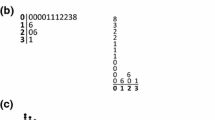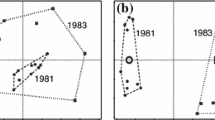Abstract
A framework is described for partitioning the matrix of between-sample distances that forms a starting point for many ecological studies into contributions attributable to different factors in a structured data set. This partitioning enables a series of ordinations to be produced that better enable an insight to be gained into the effects of the factors. More detailed application of the same partitioning provides a decomposition of each factorial effect into single degree-of-freedom contrasts, which enables reasons for observed trends to be investigated. The methods are illustrated by application to data from a study of marine community structure.
Similar content being viewed by others
References
Bray, J. R., and Curtis, J. T. (1957), “An Ordination of the Upland Forest Communities of Southern Wisconsin,” Ecological Monographs, 27, 325–349.
Clarke, K. R. (1993), “Non-Parametric Multivariate Analyses of Changes in Community Structure,” Australian Journal of Ecology, 18, 117–143.
Everitt, B. S. (1993), Cluster Analysis (3rd ed.). London: Arnold.
Everitt, B. S., and Rabe-Hesketh, S. (1997), The Analysis of Proximity Data. London: Arnold.
Field, J. G., Clarke, K. R., and Warwick, R. M. (1982), “A Practical Strategy for Analysing Multispecies Distribution Patterns,” Marine Ecology Progress Series, 8, 37–52.
Gower, J. C., and Krzanowski, W. J. (1999), “Analysis of Distance for Structured Multivariate Data and Extensions to Multivariate Analysis of Variance,” Applied Statistics, 48, 505–519.
Kempton, R. A., and Taylor, L. R. (1976), “Models and Statistics for Species Diversity,” Nature, 262, 818–819.
Krzanowski, W. J. (1988), Principles of Multivariate Analysis, a User’s Perspective, Oxford: Clarendon.
Legendre, P., and Anderson, M. J. (1999), “Distance-Based Redundancy analysis: Testing Multispecies Responses in Multifactorial Ecological Experiments,” Ecological Monographs, 69, 1–24.
May, R. M. (1975), “Successional Patterns and Indices of Diversity,” Nature, 258, 285–286.
Pearson, E. S., and Hartley, H. O. (1966), Biometrika Tables for Statisticians (Vol. 1, 3rd ed.), Cambridge: University Press.
Pillar, V. de P., and Orloci, L. (1996), “On Randomization Testing in Vegetation Science: Multifactor Comparisons of Releve Groups,” Journal of Vegetation Science, 7, 585–592.
Widdicombe, S., and Austen, M. C. (2001), “Interactions Between Physical Disturbance and Organic Enrichment: An Important Element in Structuring Benthic Communities,” Limnology and Oceanography, 46, 1720–1733.
Author information
Authors and Affiliations
Corresponding author
Rights and permissions
About this article
Cite this article
Krzanowski, W.J. Multifactorial analysis of distance in studies of ecological community structure. JABES 7, 222–232 (2002). https://doi.org/10.1198/10857110260141256
Received:
Accepted:
Issue Date:
DOI: https://doi.org/10.1198/10857110260141256




